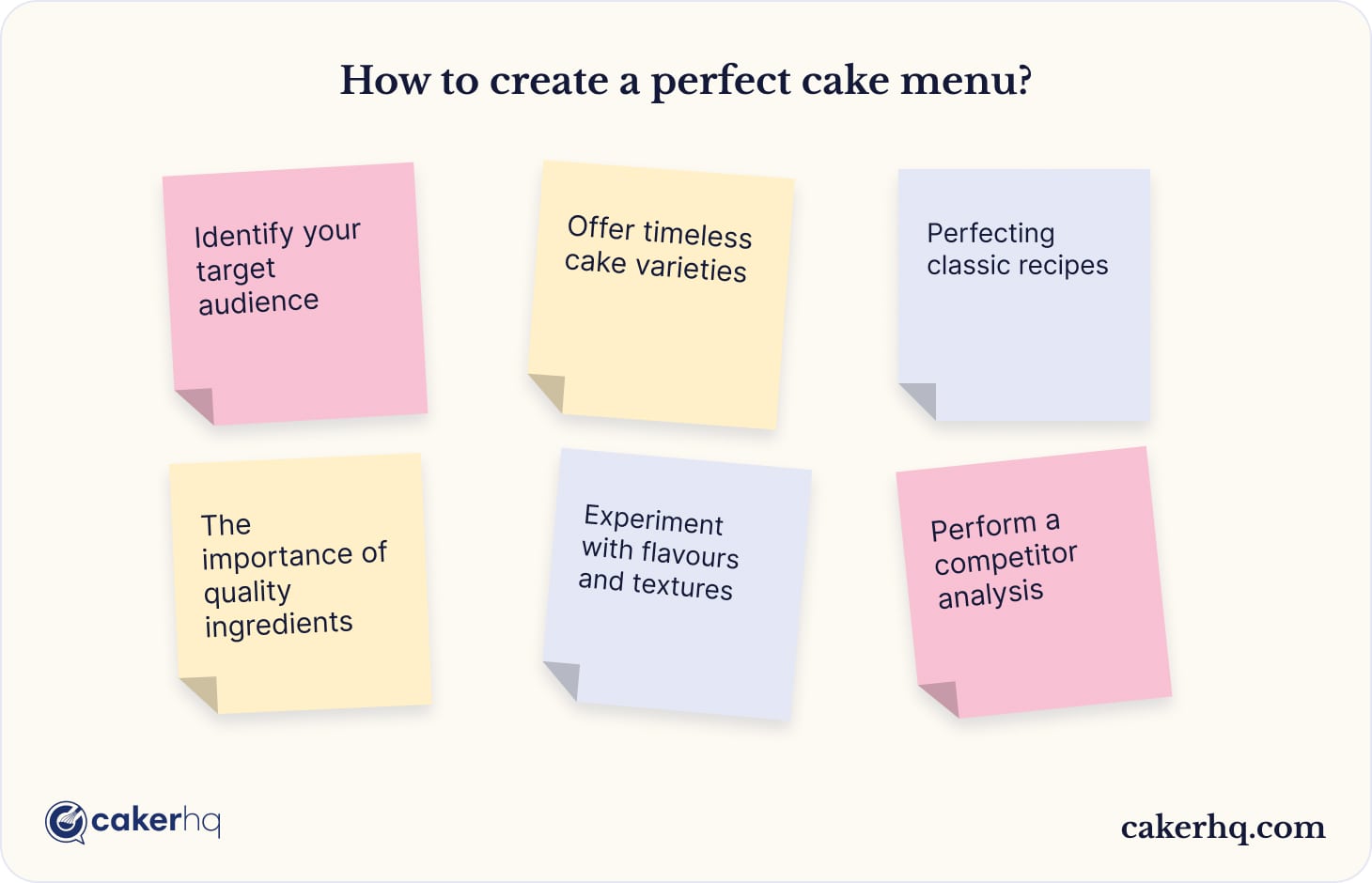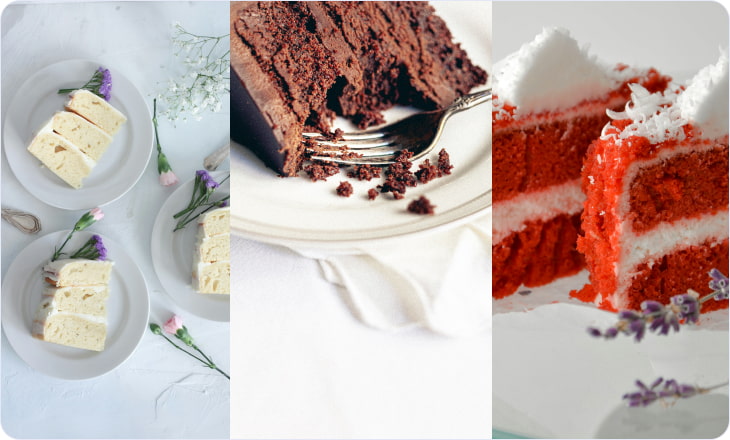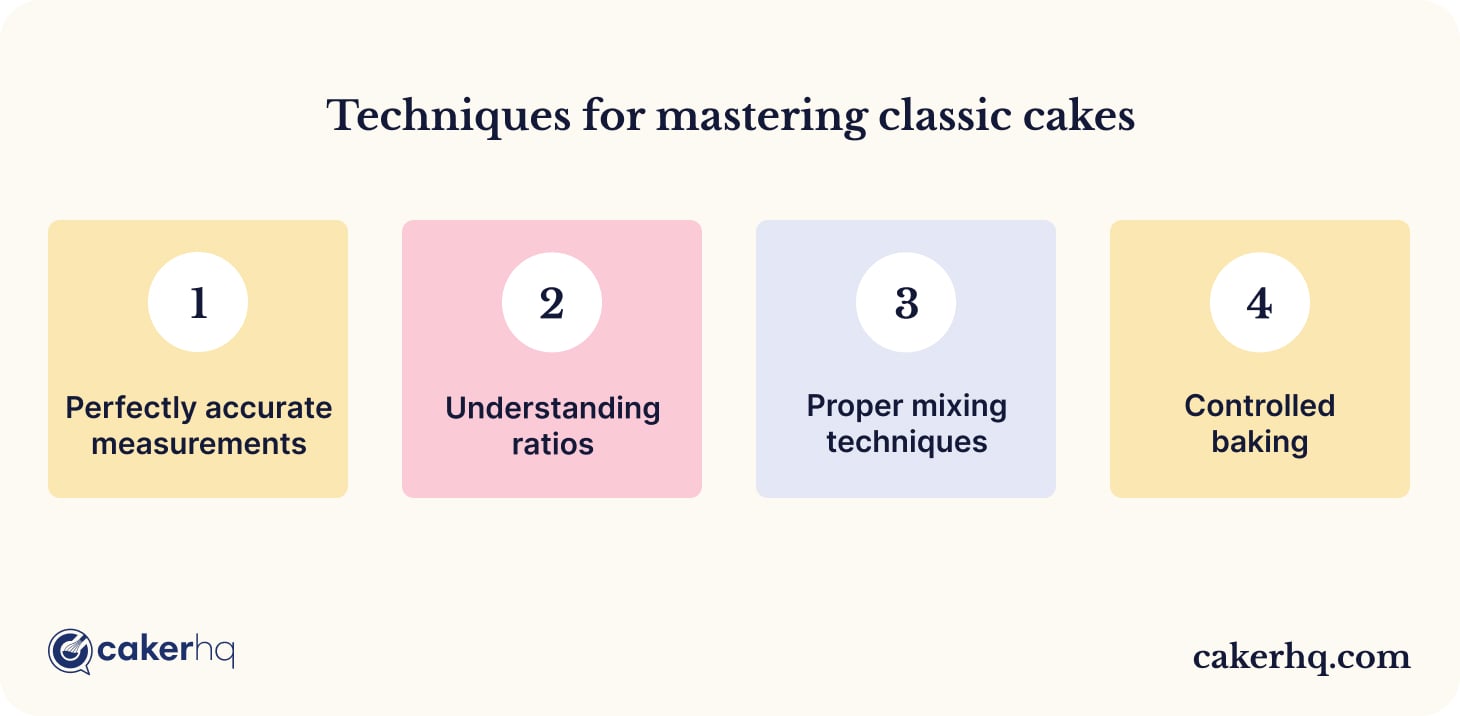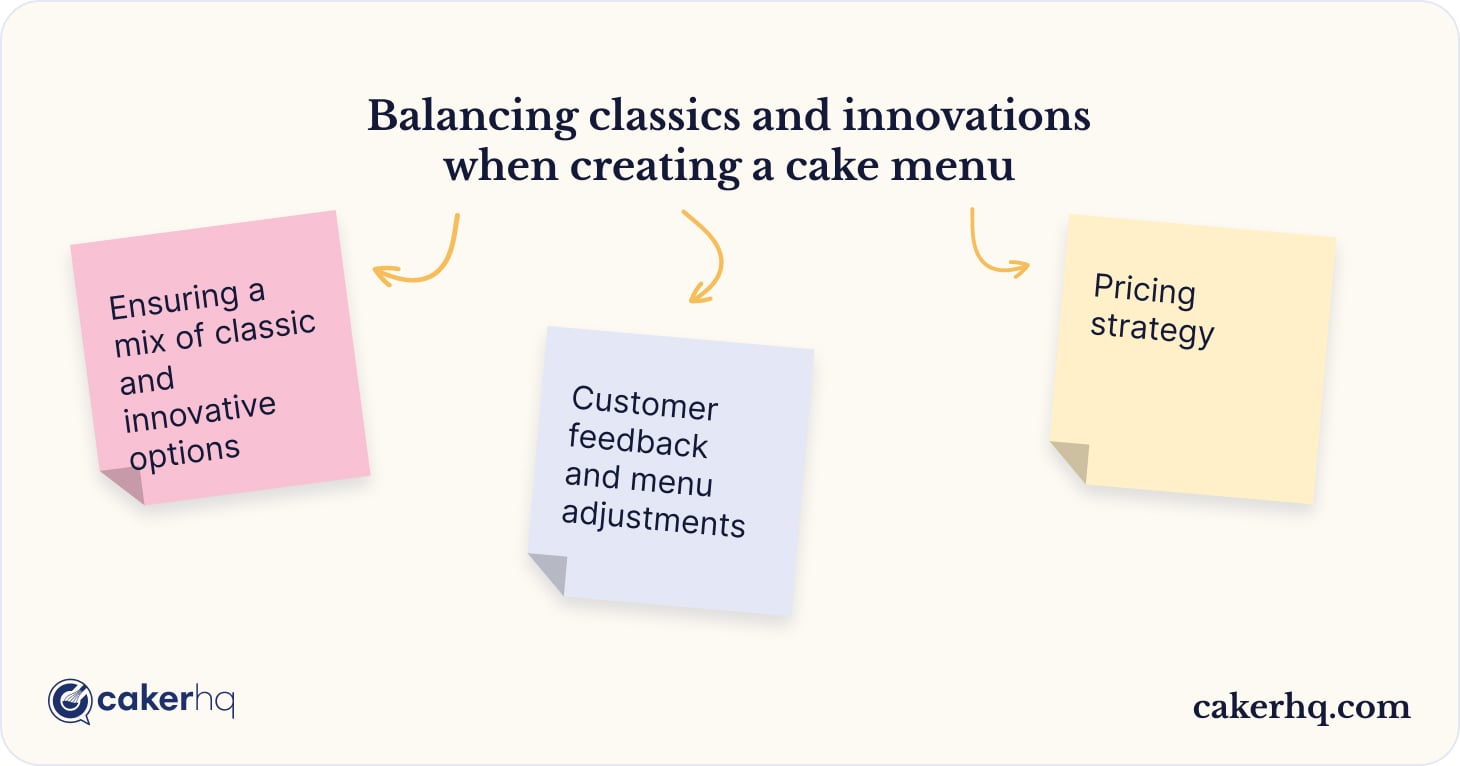If you think about it, developing a custom cake menu is as important as making cakes themselves. A thoughtful menu is a reference point, which can help you reach consistency in your offerings.
In this piece, we will look into creating a successful cake menu, listing tonnes of tips and ideas for you to consider. Collecting them in one place, i.e., in this article, can be helpful in case you don’t know where to start or are looking to improve your existing offerings.
How to create a perfect cake menu?
Creating the perfect cake menut is not as easy as it seems. All perfect cake menu ideas are a blend of understanding your audience, analysing market trends, mastering classic recipes, and continually innovating. Let’s look at what you need to create a perfect menu.
Identify your target audience
Learning your customers is the first and absolutely the most important thing to do. Simply put, the demand often dictates your offering. Thus, what you put on the menu depends on who your customers are.
In this regard, your buyers’ demographics and preferences should be your first priority. They often consist of things like average age, location, gender, and approximate income level. These demographics are important to know as they can greatly affect taste preferences, spending habits, and dietary restrictions.
Knowing how to collect and analyse them is another challenge, though. To tackle it, you can create various surveys, use the power of social media, and analyse sales data. You can even combine these ways for maximum efficiency.
Additionally, a large portion of data can be gained from the feedback you receive. The bigger businesses grow, the more they tend to start neglecting feedback, which is a crucial mistake. Regularly look into customer feedback to see what people like and what should be improved.
Read also: Top Cake Business Mistakes and How to Avoid Them
Offer timeless cake varieties
Creating a menu that includes timeless cake varieties ensures that your business appeals to a wide range of customers. These classic cakes, whether they're universally loved favourites or regional specialties, form the backbone of a well-rounded menu. In order to not get lost, let’s list a few.
Popular classic cakes
Needless to say, classic cakes are perennial favourites. They have broad appeal and are often expected by customers. Including these staples ensures your menu caters to a wide audience. Some of these eternal classics include:
Source: Unsplash, Unsplash, Unsplash
- Vanilla cake. It is a timeless choice that offers simplicity and elegance. Its light, fluffy texture, and sweet flavour make it a versatile option suitable for any occasion. It's often paired with various frostings and fillings, allowing for creative customisation while maintaining its classic appeal.
- Chocolate cake. Rich and decadent, chocolate cake is a must-have on any menu. Its deep, satisfying flavour makes it a favourite for casual and celebratory occasions. Variations like dark, milk, and white chocolate can cater to different preferences.
- Red velvet cake. With its striking red colour and subtle cocoa flavour, red velvet cake is both visually appealing and delicious. It's typically paired with a tangy cream cheese frosting, creating a perfect balance of flavours. Due to its elegant appearance and striking taste, this cake is particularly popular for weddings, holidays, and special events.
Regional and cultural favourites
Apart from timeless classics, incorporating cakes that are popular in Australia or in your specific region can help your business connect with the local community and attract a broader customer base. Specifically in Australia, you can choose several cakes to enhance your menu with local favourites.
- Lamingtons. These are a quintessential Australian treat. Basically, they are sponge cakes cut into squares, dipped in chocolate, and rolled in desiccated coconut, often filled with jam or cream.
- Vanilla slice. Vanilla slice is another popular treat in Australia. This dessert features layers of flaky puff pastry filled with a thick, creamy vanilla custard and often topped with a sweet icing or dusting of powdered sugar.
- Anzac biscuits. Inspired by the traditional Anzac biscuits, an Anzac cake incorporates the flavours of oats, coconut, golden syrup, and butter. This moist, spiced cake can bring the beloved Anzac biscuit flavours into a new form.
- Queensland's banana cake. Queensland, known for its abundant banana production, has popularised banana cake. It's a comforting, homey cake that appeals to all ages and can be paired with a simple cream cheese frosting or left plain.
- Lemon myrtle cake. Lemon myrtle, another native Australian plant, offers a citrusy flavour that can be used to create a light and fragrant cake. Pairing lemon myrtle with classic flavours like vanilla or berries can create a wonderful cake flavour option.
Perfecting classic recipes
Traditional recipes and cakes, although super popular, are very demanding in terms of recipes. They require meticulous attention to detail, consistent practice, and a thorough understanding of baking techniques to deliver them constantly perfect.
Techniques for mastering classic cakes
For starters, it is crucial to follow recipes precisely. Here are a few tips to do so:
- Perfectly accurate measurements. Even smaller fluctuations can alter the cake’s taste, texture, etc. Thus, document all proportions and measurements for each cake. Then, a kitchen scale can be used to measure precise ingredients. This ensures consistency in your recipes and avoids variations that can affect the final product.
- Understanding ratios. Familiarise yourself with the basic ratios of cake ingredients (flour, sugar, fat, and liquid). This knowledge allows you to make adjustments while maintaining the integrity of the recipe.
- Proper mixing techniques. Various cakes require different mixing methods to deliver the right texture. For example, a butter cake needs thorough creaming of butter and sugar, while a sponge cake requires gentle folding to retain air bubbles. It would be perfect not only to remember but also to meticulously document all techniques along with the recipe.
- Controlled baking. No one knows your appliances better than you, but even the smallest fluctuations in temperature can change the cake. Thus, an oven thermometer is used to ensure accuracy.
Implementing a quality control system
A quality control system ensures that every cake meets your high standards and is perfect position on the menu. This involves regular checks and processes to maintain consistency and quality in your baking.
To make sure all goods are as perfect as they seem in recipes, standardise your recipes. Document them in great detail, including ingredient measurements, mixing instructions, and baking times.
Additionally, conduct regular taste tests to evaluate the flavour, texture, and appearance of your cakes. If you notice strange variations, you can also keep detailed logs of each baking session, noting any variations or issues encountered. This can help identify patterns and areas for improvement.
Looking for a place to find new customers? Showcase your goods on CakerHQ! Sign up now
The importance of quality ingredients
The foundation of any exceptional cake lies in the quality of its ingredients. Using high-quality ingredients not only enhances the flavour and texture of your cakes but also elevates the overall customer experience.
Fresh, premium ingredients
The quality of your ingredients significantly impacts the taste and texture of your cakes. By sourcing fresh, high-quality ingredients, you can ensure that each cake you produce meets the highest standards of excellence. Fundamental ingredients you should absolutely focus on include:
- Premium flour. The type and quality of flour used can greatly affect the structure and crumb of your cakes. Opt for unbleached, high-protein flour for a better rise and texture.
- Fresh eggs. They contribute to the richness, moisture, and structure of cakes. Using fresh, free-range eggs can enhance these qualities and add a richer flavour.
- Real butter. It adds flavour and moisture to cakes. Using high-fat, unsalted butter ensures a rich, creamy taste and better control over the salt content in your recipes.
- Pure vanilla extract. Real vanilla extract, as opposed to imitation vanilla, provides a more authentic and intense flavour, enhancing the overall taste of your cakes.
- Quality chocolate. For chocolate cakes, using high-quality chocolate with a high cocoa content ensures a deep, rich flavour and smooth texture.
Local and seasonal ingredients
Sourcing locally and seasonally not only supports local farmers and producers but also ensures that you are using the freshest ingredients available. Local produce, such as berries, citrus fruits, and nuts, can add vibrant flavours to your cakes and highlight regional specialties.
Simply put, fresh, local dairy products like milk, cream, and butter can enhance the flavour and texture of your cakes. Besides, with seasonal fruits in your cakes, you can ensure that you are using the freshest and most flavourful ingredients, which can be a huge advantage for your business.
Experiment with flavours and textures
Diversity in the menu is what makes it stand out from the competition and cater to people with intricate tastes. In this matter, you can let your imagination go wild as long as the recipes you come up with are edible.
For instance, mixing flavours is one thing that always works. Combinations of sweet and savory or exotic spices can create unique cakes. Some of the most notable examples are chocolate with sea salt, caramel with rosemary, or a lavender-infused lemon cake. Yet, nothing stops you from coming up with your own ideas.
Speaking of textures, they can enhance the cake experience, too. Adding crunch with nuts or seeds can do wonders! A combination of smooth and crunchy layers, varied frosting techniques, and serving with contrasting temperatures, like a warm cake with cold ice cream, can create unforgettable experiences.
Lastly, experiments with decorations matter as well! Make your cakes visually appealing with elegant designs, creative decorations, layered and tall cakes, vibrant colours, and unique shapes. Fresh flowers, edible gold leaf, and seasonal fruits can enhance the visual appeal.
Seasonal and limited-time offerings
Seasonal cakes take advantage of the freshest ingredients available, ensuring superior taste and quality. Using fruits, spices, and other seasonal ingredients can boost the appeal of your cakes, making them a long-awaited item on the menu.
Simply put, fresh ingredients like strawberries in summer or pumpkins in autumn provide a rich, authentic taste that processed ingredients cannot match. The only thing you need to do is to have a special recipe perfectly accounting for these seasonal ingredients. Besides, do not forget about the higher nutritional value seasonal fruits and berries have. This aspect can make your cakes a go-to choice for health-conscious customers.
Another wonderful advantage seasonal offerings have is their rarity and limited-time availability. Featuring such positions on the menu creates a sense of urgency, prompting customers to purchase before the product is no longer available.
Simply put, promoting your seasonal and limited-time offerings effectively can generate buzz and attract more customers. Besides, it can be done quite easily.
- Banners, popups, and highlighted product cards. You can utilise various user interface (UI) elements to highlight seasonal cakes on your website and CakerHQ profile. Use special fonts, popups or highlight product cards to let users know certain cakes are limited and there is an end date for their availability.
- Social media marketing. Use your social media accounts to announce new seasonal offerings, promote them, and let users react to their appearance. Additionally, you can share behind-the-scenes content, videos, and customer reviews to create excitement.
- In-store displays. If you have an offline store, apart from a home-based bakery, create eye-catching cake menu design and in-store displays to showcase your seasonal cakes. Use signage, samples, and attractive packaging to draw attention.
Yet, it is important to not exploit customers F.O.M.O, i.e., fear of missing out. Make sure to inform them that limited-time products return regularly. Additionally, emphasise the importance of preordering to mitigate issues.
Perform a competitor analysis
Your direct and indirect competition is another source of data you could exploit. If your menu is your primary concern, see what others have to offer in theirs.
Analyse the menus of other cake-making businesses in your area to understand what they offer and at what price points. If there are several of them, look for patterns in popular items and note any unique offerings that set them apart. With this knowledge, you will see the success formula, i.e., understand why people like their offering. Next, you can identify gaps to fill in your own menu.
With a thorough competitor analysis, you can identify many things. These could be some areas where competitors may be lacking or where you can offer something unique. This, for instance, could be a particular flavour, a dietary-friendly option, or an innovative presentation style. Needless to say, filling these gaps can entice their customers and attract new ones, differentiating your business.
Balancing classics and innovations
Hitting the sweet spot between offering all-time favourites and innovative cakes is vital. Basically, a balanced menu will have all the chances to appeal to a wide range of buyers while keeping your cake-making processes exciting and fresh.
Here are different aspects of the menu you should balance to deliver an exceptional menu.
Ensuring a mix of classic and innovative options
As mentioned earlier, a diverse menu should include both all-time favourite classics and innovative new cakes.
On the one hand, the classic cakes we listed earlier appeal to traditional tastes and provide a reliable foundation for your menu. In any bakery, people love these positions, and they often sell best. These classic options cater to customers who seek comfort and familiarity in their dessert choices. They are often associated with celebrations and special occasions, ensuring steady demand.
On the other hand, innovative cakes are essential, too. They often feature unique flavours, textures, and presentations, catering to people who always seek new tastes. As previously mentioned, innovations can come in various forms, be they exotic flavour combinations or superior, eye-catching presentations.
To balance things out in your menu, consider a ratio of classics to innovations that suit your target audience.
For instance, you might aim for a 70-30 split, with 70% of your menu dedicated to beloved classics and 30% showcasing new and experimental cakes. The ratio itself should be dynamic, though. You should adjust it based on the demand or feedback from your users.
When it comes to introducing new cakes, caution is advised. One thing you can do is to tie new cake offerings to special days or holidays, introducing cakes on special occasions. Accompanied by great marketing messaging, you can attract a lot of people to try them.
Besides, featuring new cakes seasonally or for special occasions, you can also test their popularity without overwhelming your production capacity. After all, this approach allows you to gauge customer interest and refine recipes before making them permanent fixtures on your menu.
Customer feedback and menu adjustments
Fine-tuning your menu without a customer feedback input is difficult and may lead to unwanted results. In other words, your buyers’ feedback and reviews are the best advisors on how you should handle your menu, which bakes to add, and what should be removed.
Collecting feedback, though, is easy. Comments, reviews, surveys, and various social media interactions can provide tons of information in this regard. However, people rarely share opinions unless they are asked to. Thus, encourage your buyers to share their thoughts and suggestions and make it easy for them to provide feedback through various channels, such as your website, email, and in-store interactions.
When analysing comments, take note of recurring comments and suggestions, as these form patterns that can highlight areas for improvement or opportunities for new offerings. Simply put, if multiple customers request a gluten-free option or a lower-sugar variant, it indicates a potential demand that you can cater to.
Pricing strategy
When it comes to setting prices for your baked goods, several considerations should be taken into account.
Pricing classics vs. innovative cakes
It’s no secret that all-time favourite cakes often have established price points based on market standards and customer expectations. Altering the average price may have various consequences.
- On the one hand, selling classic cakes much cheaper than your competitors may raise questions about the quality of the ingredients or create concerns about your workplace.
- On the other hand, setting the price too high may repel users because they can easily buy similar cakes elsewhere.
Therefore, your cakes should be competitively priced to ensure they remain accessible to a broad audience. When setting prices, make sure they reflect the quality and value of your products. On CakerHQ, for instance, you can freely use a cake calculator, which allows you to specify various cost-forming factors and calculate highly accurate cake prices.
Innovative cakes, however, can command higher prices due to their unique designs, often rare ingredients, and complex creation techniques. When pricing your innovative cakes, consider the additional costs associated with sourcing rare ingredients or employing specialised baking methods. Highlight these unique aspects in your marketing to justify the higher price and appeal to customers looking for exclusive and premium experiences.
Offering value while maintaining profitability
Finding a balance between offering value to users and maintaining profitability is another challenge for you to overcome on your way to a successful menu. Hence, to preserve both of these aspects, a cost analysis for each cake must be conducted.
One thing you absolutely have to do is factor in ingredient costs, labour, and overheads to set a baseline price. Then, adjust for market positioning—classics should be competitively priced, while innovative cakes can be positioned as premium offerings.
Additionally, consider offering tiered pricing, as its flexibility can come in handy. According to this model, you can make basic versions of cakes super affordable, with options to upgrade to deluxe versions with additional features.
For instance, a basic chocolate cake should have a base price, while the upgraded version with gourmet chocolate ganache and artisanal decorations should be priced as premium. This approach allows customers to make choices according to their budget while providing options for those willing to pay more for a premium experience.
Additionally, implement promotions and bundle deals to encourage sales without compromising profitability. Offering a discount on a new cake when purchased with a classic favourite can introduce customers to innovative options while maintaining overall sales volume.
Bottom line
Summing this extensive article up, the menu is an aspect that should perfectly blend both creativity and consistency. You can come up with various ideas, offerings and bakes, yet it should always be understandable and reliable. In other words, people definitely appreciate interesting offerings, but they also rely on it in planning purchases, for instance.
Once you find how to strike a balance between creativity and consistency, you will create a consistent and reliable menu that can still fascinate people with its creativity. At CakerHQ, we sincerely hope the tips we collected and listed in this piece will be of great help in creating your ideal bakery cake menu.
If there are any other aspects of the cake-making business you need to study in-depth, feel free to refer to our blog. It is multifaceted, featuring articles not only about cake-making itself but also about how to run a business, with its various aspects and challenges.



